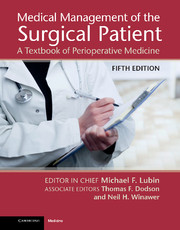Book contents
- Frontmatter
- Dedication
- Contents
- List of Contributors
- Preface
- Introduction
- Part 1 Perioperative Care of the Surgical Patient
- Part 2 Surgical Procedures and their Complications
- Section 17 General Surgery
- Section 18 Cardiothoracic Surgery
- Section 19 Vascular Surgery
- Section 20 Plastic and Reconstructive Surgery
- Section 21 Gynecologic Surgery
- Section 22 Neurologic Surgery
- Section 23 Ophthalmic Surgery
- Section 24 Orthopedic Surgery
- Chapter 116 Arthroscopic knee surgery
- Chapter 117 Total knee replacement
- Chapter 118 Total hip replacement
- Chapter 119 Fractures of the femoral shaft
- Chapter 120 Hip fractures
- Chapter 121 Lumbar spine surgery
- Chapter 122 Surgery for adult spinal deformity (scoliosis or kyphosis)
- Chapter 123 Cervical spine surgery
- Chapter 124 Surgery of the foot and ankle
- Chapter 125 Lower extremity amputations
- Chapter 126 Surgical procedures for rheumatoid arthritis
- Section 25 Otolaryngologic Surgery
- Section 26 Urologic Surgery
- Index
- References
Chapter 119 - Fractures of the femoral shaft
from Section 24 - Orthopedic Surgery
Published online by Cambridge University Press: 05 September 2013
- Frontmatter
- Dedication
- Contents
- List of Contributors
- Preface
- Introduction
- Part 1 Perioperative Care of the Surgical Patient
- Part 2 Surgical Procedures and their Complications
- Section 17 General Surgery
- Section 18 Cardiothoracic Surgery
- Section 19 Vascular Surgery
- Section 20 Plastic and Reconstructive Surgery
- Section 21 Gynecologic Surgery
- Section 22 Neurologic Surgery
- Section 23 Ophthalmic Surgery
- Section 24 Orthopedic Surgery
- Chapter 116 Arthroscopic knee surgery
- Chapter 117 Total knee replacement
- Chapter 118 Total hip replacement
- Chapter 119 Fractures of the femoral shaft
- Chapter 120 Hip fractures
- Chapter 121 Lumbar spine surgery
- Chapter 122 Surgery for adult spinal deformity (scoliosis or kyphosis)
- Chapter 123 Cervical spine surgery
- Chapter 124 Surgery of the foot and ankle
- Chapter 125 Lower extremity amputations
- Chapter 126 Surgical procedures for rheumatoid arthritis
- Section 25 Otolaryngologic Surgery
- Section 26 Urologic Surgery
- Index
- References
Summary
The femur is the largest bone in the body and has a large soft tissue muscle mass surrounding it. The femoral shaft includes the region 5 cm below the lesser trochanter and 9 cm above the knee joint, and is termed the diaphysis. The estimated incidence of fractures of the femoral shaft in the USA is around one fracture per 10,000 persons per year. There is a bimodal age distribution of femur fractures with one peak in the 20s and one peak in the 60s.
Most femur fractures tend to occur secondary to high-energy trauma such as motor vehicle accidents, pedestrians struck by vehicles, falls from a height, or gunshots. The force required to fracture a femur may also cause a multitude of other associated injuries, most commonly to the head and chest. Therefore, a thorough and complete evaluation by a systematic protocol is warranted followed by any needed resuscitation. High-energy femoral shaft fractures may lose up to 1–3 units of blood into the thigh musculature causing hemodynamic instability, so close monitoring is indicated.
- Type
- Chapter
- Information
- Medical Management of the Surgical PatientA Textbook of Perioperative Medicine, pp. 721 - 723Publisher: Cambridge University PressPrint publication year: 2013

